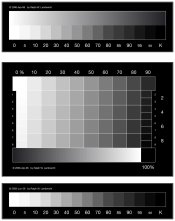I'm just about to crank up Photoshop and make myself a step wedge to help with my salt and cyanotype printing. There are some nice tutorials on YouTube on how to do this but it will take me a while and I don't enjoy messing with Photoshop. I spend enough time on computers for work.
Why can't I download one from somewhere? Am I missing something? There are a bunch of tutorials on how to make these things but it only needs to be done once by one person. Why do we all have to do it individually?
Would anyone like to share their step wedge image file or know of the location of one?
[ I looked at buying a Stouffer 21 step step wedge but they are £24 here in the UK - double the US price. I have a printer sitting here and some acetate and don't need anything too accurate. Plus I'm tight and that is 24g of Silver Nitrate or a big pad of water colour paper. ]
Why can't I download one from somewhere? Am I missing something? There are a bunch of tutorials on how to make these things but it only needs to be done once by one person. Why do we all have to do it individually?
Would anyone like to share their step wedge image file or know of the location of one?
[ I looked at buying a Stouffer 21 step step wedge but they are £24 here in the UK - double the US price. I have a printer sitting here and some acetate and don't need anything too accurate. Plus I'm tight and that is 24g of Silver Nitrate or a big pad of water colour paper. ]




